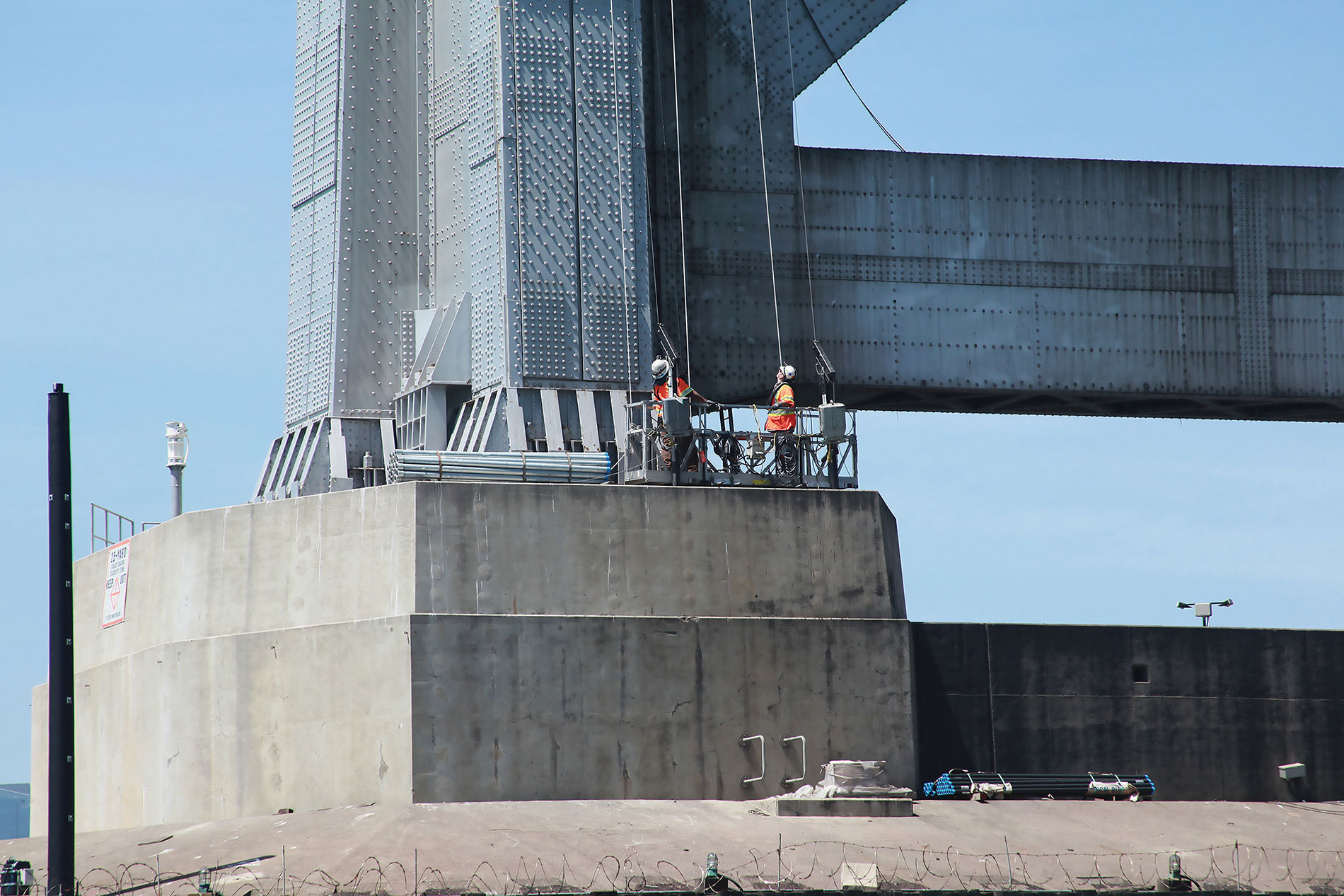Each spring, the nation’s student bodies, businesses, organizations and local governments—including the United States—receive a report card measuring performance. Sometimes the grades aren’t anything to write home about.
According to the American Society of Civil Engineers’ 2021 “Report Card for America’s Infrastructure,” released in March, the United States received an overall grade of C- for the state of its infrastructure. The report contends that the nation’s failure to adequately upgrade its decades-old roads, bridges, tunnels, water systems, electrical grid, public transit system and much more, combined with the demands of a growing population and the greater frequency of severe storms and natural disasters, have left the infrastructure in woeful disrepair and, in many cases, unsafe. Among the report’s alarming findings:
- 42% of the United States’ 617,000 bridges are more than 50 years old, and more than 46,000 are rated as structurally deficient.
- Within the nation’s 2.2 million miles of underground water pipes, a water main break occurs every 2 minutes, resulting in the daily loss of an estimated 6 billion gallons of treated water nationwide.
- Thanks to wear and tear on our nation’s highways and roads, more than 40% were rated in “poor” or “mediocre” condition.
- 19% of public transit vehicles and 6% of fixed guideway elements such as tracks and tunnels were rated in “poor” condition.
A promising plan
President Joe Biden’s proposed $2 trillion American Jobs Plan could have a profound impact on the economy, especially with construction accounting for half of the total spend, including $621 billion for transportation initiatives involving roads, bridges, electric vehicle charging stations and airports. Another $698 billion is earmarked to upgrade the electrical grid, water systems, broadband, school systems and more.
The infrastructure plan aims to modernize 20,000 miles of roads and highways and repair the nation’s 10 largest and most economically significant bridges that are no longer safe, as well as 10,000 smaller bridges in desperate need of upgrade, in addition to a long list of other much-needed infrastructural enhancements.
Slated to be funded by an increase in the corporate tax rate from 21% to 28%, Richard Branch, Dodge Data & Analytics’ chief economist, warned that the American Jobs Plan “is far from a sure thing” during his April webinar on the impact such an infrastructure program could have on construction starts.
“It’s more an opening salvo,” he said.
Branch suggested that there are many unknowns about how the plan will shake out over the coming months, and that it will certainly face significant push-back in the Senate that will likely lead to its being scaled back.
However, “even a more limited infrastructure program would have a net sizable positive impact on construction starts over our forecast horizon,” he said. “If an infrastructure program gets passed in 2021, it will be a huge step up for public works and construction just when we need it as we’re coming out of the pandemic-fueled recession.”
In a May 6 speech in Lake Charles, La., Biden said that his vision of “building back better” could lead to the creation of “up to 16 million good-paying jobs” within what he described as a “blue-collar blueprint to rebuild America and supercharge our economy.”
A historic opportunity
Experts in the electrical contracting industry agree that the initiative couldn’t have come at a better time. With more electricians currently exiting the industry than joining it each year—electrical contracting is facing a well-known shortage of skilled labor, to the tune of an estimated 85,000 unfilled positions by 2024, according to recent forecasts by the U.S. Bureau of Labor Statistics—this historic proposal could provide enhanced job security for existing contractors and help reconcile the labor gap by attracting more talent to the field.
James Farrell, executive director of government affairs for the National Electrical Contractors Association, is among the many proponents of the proposed plan.
“The state of our nation’s infrastructure is a mess, and we’re at a major disadvantage in terms of its efficiency, quality and safety when compared to many developed countries,” Farrell said. “The American Jobs Plan is a very ambitious proposal that will help rebuild and modernize our nation’s infrastructure, and, if this plan or any infrastructure plan is enacted with significant federal resources, it would be a huge boost to the electrical construction industry.”
Among its many benefits, “we anticipate a number of jobs to be created as projects roll out from the infrastructure plan over the next few years, as economic studies show that every $1 billion in infrastructure investment creates 28,500 direct and indirect jobs, providing our economy and American taxpayers with a high return on investment,” Farrell said.
Contractors specializing in infrastructure-related projects also welcome the proposed plan.
“The upgrade of our country’s infrastructure is long overdue,” said Matthew J. Englert, COO at Rosendin Electric, a century-old contracting firm based in San Jose, Calif., that provides electrical and communications infrastructure to the renewable-energy sector, airports and railways throughout the Western, Southeastern and Southwestern United States.
“A cost-effective and efficient public transit system doesn’t exist, our electrical transmission and distribution system needs to be reconfigured and upgraded to handle the many gigawatts of renewable energy, which is being installed, and water/wastewater capacity needs to increase to handle our growing population.”
However, he said, “the significant investment proposed in the plan could equate to $100 billion–$200 billion in electrical contracting activity and up to 600 million incremental worker-hours, which is a tremendous amount of work and a great opportunity for our country.”
According to Anthony Mann, president and CEO of E-J Electric Installation Co., New York, the plan’s goals reinforce much of the work the company is currently pursuing.
“Many of the projects we’ve completed and are currently working on have the goal of updating and future-proofing systems, such as the signal work we’ve been performing for the Metropolitan Transportation Authority in order to update the outdated system trains use to communicate,” Mann said. “Other upgrades long overdue in our area involve the Port Authority Bus Terminal and new Gateway Program, a comprehensive rail investment program involving a partnership between New York, New Jersey and Amtrak.”
E-J Electric is a 122-year-old contracting firm that supports infrastructure projects—fast-track, design-build projects for bridges, tunnels, roads, subways, airports, utilities and renewable energy—throughout New York, New Jersey and Connecticut.
Mann said the company has also been involved in projects related to a recent program that aims to bring more electric vehicles into New York through the accelerated development of charging stations, increased availability of electric car rebates and enhanced support for New York State’s electrification and clean-energy goals.
E-J Electric Installation Co. workers upgrade New York City’s Queens Midtown Tunnel.
Photo courtesy of E-J Electric Installation Co.
“If the American Jobs Plan is enacted, it will allow critical projects to move forward across many state and city agencies, which means much-needed improvements to bridges, tunnels, transit systems, airports and more,” Mann said. “There will be a significant amount of work on the horizon for the entire construction industry as a whole.”
From her vantage point in Washington state, Mary Lerdahl, Emerald Consulting Services, sees a tremendous role for the American Jobs Plan to play when it comes to strengthening the nation’s economy and enhancing our global competitiveness. Emerald consults on public and private projects for the city of Seattle, King County, the University of Washington and Sound Transit.
“In our area in particular, we’ve experienced a great population increase and our roads and highways are more crowded than ever,” Lerdahl said. “Despite having a good public transportation system, we still need to invest in more lanes to accommodate this growth. If enacted, the American Jobs Plan will make a great deal of work available to electrical contractors as well as other trades.”
A new era of hope
These experts confirm that the plan’s goal of jump-starting contracting activity nationwide won’t come without its challenges.
According to Farrell, “a challenge we always face is getting significant federal and private sector investment and, in some areas, we have shortages of skilled labor.”
Englert agreed, noting that “the biggest challenge will be attracting, developing and retaining a workforce that can adequately execute the work required to support this tremendous program.”
Mann worries that the plan could end up putting more pressure on the price of materials, especially copper, while Lerdahl fears that the capacity of her region’s electrical contractors to perform heavy highway electrical work may be limited, as many of the local contractors in her area specialize in commercial vertical construction rather than highway electrical work.
Despite these concerns, however, contractors feel optimistic about the promise the American Jobs Plan—at any size or level—holds for the electrical contracting industry.
“Sustainable energy is a safe and important investment for the country to make, and, at E-J, we see renewable energy as a key component of the electrical industry’s future,” Mann said.
For Rosendin’s part, “our hope is that the industry will be able to provide a unified and collaborative solution for the highest quality product while training a workforce that will be able to grow and provide future services for our country,” Englert said.
“My hope for America is that the dollars will go to building actual infrastructure projects that create a safer, more efficient transportation system, utilizing new technologies and preparing for self-driving cars and intelligent transportation systems that can help manage traffic flow and prevent accidents and loss of life,” Lerdahl said.
In terms of supporting NECA’s mission of empowering lives and communities, Farrell concluded, “My hope is that NECA contractors will be able to continue to power our nation’s buildings, hospitals, and schools, light our highways and streets, connect transit and rail switches, install complex electrical systems at airports, operate and maintain the plants that keep our water clean and much more.”
https://www.ecmag.com/section/your-business/blueprint-rebuild-america-infrastructure-plan-could-lead-boom-electrical


